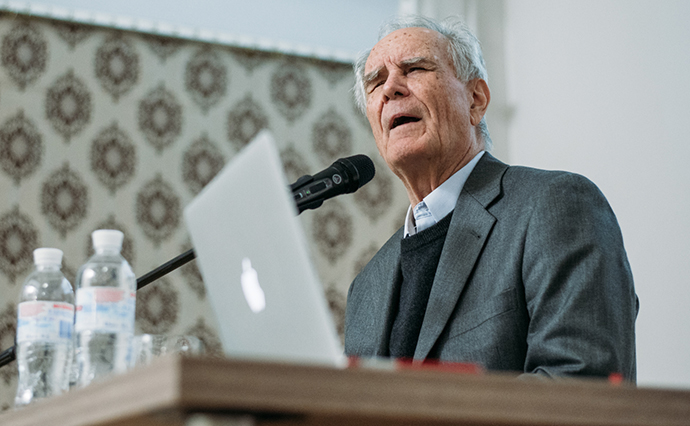Anna Agafonova, economist, member of the business community IZOne, Donetsk
 It seems to us that what we are living now has not been seen before, it seems that Donetsk’s case is unique. But other countries have already survived all this.
It seems to us that what we are living now has not been seen before, it seems that Donetsk’s case is unique. But other countries have already survived all this.
The reasons for what is happening in our country are the same as the reasons that led to World War II. In the beginning of the previous century, in Europe, as a result of instances of industrial monopoly the capital and power were concentrated in the hands of oligarchs and technocratic managers.
Liberal economies, oligarchy, corruption and lack of social lifts cost thousands of people their lives. The events in Ukraine can be easily compared with the police and private security service shooting of the peaceful demonstration “Hunger March” of the fired workers at the factories of a well-known figure, Ford.
When in April of the current year Mikhail Khodorkovsky visited Donetsk, he advised us to modernise the productions, as if it would solve Donbas’ problems. At factories with a hierarchical system of government and big volumes of production no systematic implementation of innovations, no healthy competition, no development of scientific and experimental findings are possible.
One would like to believe that he simply wasn’t aware that Donbas’ factories are dominated by 19th century technologies. A pile of old, rotting garbage cannot be modernised: there is too much of it and it is lagging behind the civilised world by eight technological breakthroughs. This is the moment when either reconstruction or free slave labor for so-called sustainability of production remain.
Even if a miracle does happen and they start modernising Azovstal, it will turn out to be very non-beneficial: together with the factory, the people also have to be “modernised” (retaught), new equipment will become obsolete within three years, and we are simply not used to systematic optimisation.
The biggest trouble of the Donbas economy is that little is known about it. A huge shadow sector, an out-of-date statistic methodology, low accountability – these are the problems of Ukraine as a whole. One cannot improve something they only have a vague impression of. When coming out to Maidan, the people had a very difficult time imagining what they were fighting against, and the name of this dragon has to be searched in the recesses of the shadow, and not the official, sector of the economy.
The Donetsk governor Taruta, first an foremost, had to gather some sort of data regarding the real state of affairs, present understandable analytics to the population, and this is what he really is to blame for.
The Donbas population should have been “decreased” a long time ago. This is the most densely populated region of Ukraine with a constantly stagnating economy, which leads to predictable civil protests and People’s Republics of Donetsk. Government programs for immigrants should have been created a long time ago. And now, how many will be left after the ATO? In fear and poverty, criminality will right long and free from experienced criminals and simply hungry people, and it means that the new economical structure has to be tolerant of the poor and connected to the law enforcement sector.
What historical experience could we make use of?
The best practices of the USA. If we are to forget about the monetary reform from Roosevelt’s New Course, Ukraine might make use of the experience of overcoming depression in the US: loan-giving and subsidising farming.
In order to provide sufficient amount of foodstuffs, the farmers received guarantees of state purchase, and the state made use of the surplus – for example, they sent it to Europe as humanitarian aid, and then the USA became the main exporter, as humanitarian aid almost always kills local production. The taxes for US citizens with revenues of less than $4000 were decreased by two-thirds, part of the capital was subject to amnesty.
Besides that, the development of the military industry helped the USA out of crises numerous times as a consequence, therefore instead of subsidising the miners, the helpless police and sellout SSU, they should just be subsidies as part of the army.
Another way is the creation of big state construction projects, investigation and legalisation of part of the shadow sector and the development of the defence industry.
The best practices of Nazi Germany. The biggest advantage and the strongest side of Germany has always been the systematic gathering of information, thanks to which it was always easier to make sense of the situation and the needs. Hitler, just like Roosevelt, provided the population with food, having created a direct food supply chain from the village to the city, avoiding commercial mediators.
The formal organisation “Peasant Estate” became the harbinger of the German industrial trade union (even as of today some types of food business are obliged to be part of a trade union and the trade-industrial chamber). On one hand, in order to overcome unemployment, labor camps and state construction sites were created, on the other, the miners were able to break out of industrial slavery thanks to non-rate loans and tax holidays.
Germany’s way after World War II was less connected to the military industry than that of the USA. Germany fully concentrated on scientific and investigative developments. And this allowed the country to become one of the leaders of the world economy even without a wide military program.
The best practices of the EU. The restructuring of economy of the industrial regions of the EU was and remain uncompromising. The world does not needs as much metal and machine-building as before. Especially the kind of metal we produce. Thatcher’s reforms regarded mostly the development of service and creative industrial economics.
The provision for small and medium businesses was not limited to the tax and loan spheres, but was followed by the development of the scientific sector and innovational policies. Micro-businesses receive one-time non-refundable subsidies and tax holidays. The main message of the restructuring is the transition from export-oriented production to production for the internal market (though, in the case of the UK, even language courses have become a beneficial export business).
Germany’s Ruhr region is one of the most successful examples of how a stagnating region may become a monument to industrial heritage, a centre for tourism and push towards the development of creative business. Ruhr’s experience is augmented by the development of universities in the region, which gives an almost instantaneous economical effect and influx of quality human resources.
Is such restructuring possible in Donbas? Not under the current conditions. The level of society that participates in the chain of creating and intellectual production and consumption is the most mobile and is mass-fleeing the region.
Therefore we don’t have too many options. And the most obvious one is to restructure Donbas’ heavy industry into a familiar one – the military industry. All the factors listed above points towards this solution.
“Does Donbas not deserve more than to become a big military base?” you may ask me. In reality, I would like to assure you, there is nothing bad about this. In post-war Germany the most economically successful regions emerged out of US military bases.
There is a saying: war to some, mother to others. If someone is living off war anyway, let it be the state and the peaceful population of Donbas. The presence of the military will not allow Donbas to remain the ghetto region which it had been turned into by the dignified and esteemed citizens and which it has been for the last 23 years.
Source: Life.Pravda
Translated by Mariya Shcherbinina


